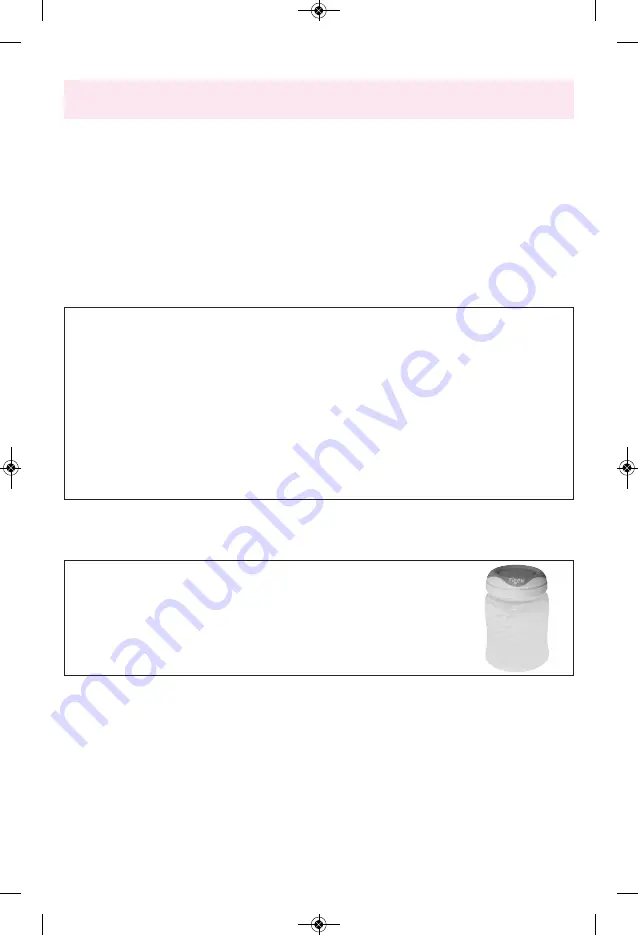
6
How to use your breast pump (cf diagram C)
Using a breast pump is a habit that needs to be acquired and you may need to try several times. Don't be discouraged if
you cannot manage it first time. If after a few minutes you are still not successful, try again later. Whatever happens, using
a breast pump should never be painful.
Before using the pump, wash your hands carefully, wash and sterilise your breast pump and assemble it in accordance with the
instructions in the previous section.
1. Place the breast shield 6 on your breast so that the nipple is in the centre. Make sure there is no space between the breast
shield and your skin to permit good suction. Always keep the breast pump upright if possible.
Comment: when the breast pump is not upright or you drop it, it cuts out automatically.
2. Switch the breast pump on. Slowly turn the start and suction regulator button 4 clockwise until you hear a "click". The breast
pump automatically adopts an effective suction rhythm: slow and intensive.
3. Then adjust the suction by turning the suction regulator button until optimum power is obtained.
If suction is insufficient, turn the suction regulator button clockwise. If suction becomes painful or uncomfortable, reduce its
strength by turning the suction regulator button in the opposite direction.
4. To stop pumping, turn the suction regulator button anti-clockwise until once more you hear a "click".
5. Cautiously unscrew the bottle 9 from the connecting ring 7 and the motor unit. Make sure the bottle remains upright.
In order to keep the milk, clip the sealing disc 13 onto the ring 12 and screw firmly onto the bottle. Be sure to follow the hand-
ling advice for the milk given below.
To use the milk you have expressed, screw the ring 12 with a teat 11 onto the bottle.
Advice for expressing your milk
During breast-feeding, baby's contact with your breast stimulates milk flow via a reflex action. In order to succeed in using
your breast pump the principle is to trigger this same reflex and thus stimulate milk flow.
- Choose a quiet spot where you can express your milk in a perfectly relaxed manner.
- Adopt a seated position that is comfortable and relaxed. Some mothers find that leaning forward slightly helps.
- The best thing is to be able to see your baby. If this is not possible, use a photo of your baby or take an item of clothing
carrying your baby's scent with you.
- Before starting the breast pump you can place a warm compress on your breast for a few minutes (for example Tigex's
soothing compresses) to relax the breast tissue making milk flow easier. You could also express your milk after a hot sho-
wer or bath.
- You can also make milk flow easier by gently stimulating your nipple (by tickling it or gently pulling down on it) or by
massaging yourself to express the first few drops of milk manually. To do this you could use the following technique: mas-
sage your breast in small circles starting from the edge of the breast and working towards the nipple then caress your
breast from the outside towards the nipple and finally lean forward and shake your breasts to encourage ejection of the
milk by gravity (cf diagram D).
How to store and feed expressed milk
Warning! Only keep milk expressed using a sterilised breast pump. Be sure to note the date and time the milk was collected
on the container. Always start by using the oldest milk.
Milk conservation:
- 4 hours at room temperature (20-25°C)
- 48 hours in the refrigerator at a temperature lower than or equal to 4°C. Never keep milk in the
refrigerator door because temperature changes are greater there.
- 4 months in the freezer at a temperature lower than -19°C.
Please note:
if you wish to freeze your milk, do so immediately. Do not freeze milk that has al-
ready been kept in the refrigerator. If you are not at home when you express your milk, keep and
transport it in a cooler or insulated bag with a refrigeration pack to comply with refrigeration
practice.
Thawing and reheating milk
Milk may be thawed by placing it in the refrigerator and using it within 24 hours. It must never be refrozen. It can also be re-
heated in a bain-marie in a saucepan, in a bottle warmer or under the hot tap. Never use a microwave oven: it reduces the
milk's nutritional quality and there is a strong risk of burning.
Milk taken out of the refrigerator must be used within an hour if left at room temperature and within half an hour if it has been
reheated.
Please note: your milk may look different after storing. Before feeding your baby, shake the milk gently to ensure the fat content
is thoroughly mixed and that the heat is spread uniformly. Then check the temperature of the milk by pouring a few drops onto
the inside of your forearm.
Source: ANSES data, July 2005. Data valid for milk kept at home and for children born at term and in good health.
NOTICE TIRE LAIT ELECT ST OK_Mise en page 1 02/12/16 14:11 Page6




























